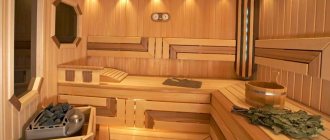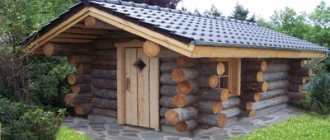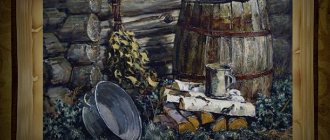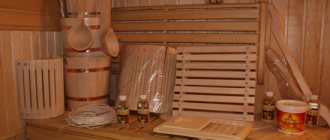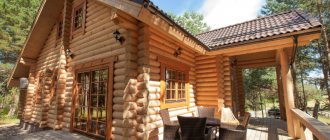Which wood is best for a bathhouse - what is better to build a bathhouse from and do the finishing?
During the construction of a bathhouse, wood is often used. It can serve not only as the main material of the building, but also act as a decoration. As for which wood is best for a bathhouse, not all wood is suitable for this construction - only certain species that have special qualities.
The variety of building materials on sale can cause confusion. Many companies are currently designing baths. They offer various materials as main or finishing materials. In any case, even if the structure is made of brick, only wood is used in the steam room. It is important to decide which wood to cover the steam room with. So which wood is better to build a bathhouse from?
Pine and spruce
Log cabins made of pine have been popular for many years, since this type of wood is distinguished by its low price and good qualities. The logs are light, and the fibers of the material are quite strong. Thanks to this, such wood weighs little and is easy to process.
Pine log houses are slightly deformed under the influence of weather conditions, since this material is flexible and expands and contracts to a small extent when temperature changes occur.
Since the bathhouse is not the most important building on the site, not such a large amount is allocated for it. Since pine is a fairly cheap building material, it is often chosen for this construction. This wood also has one interesting feature - it emits a good, pleasant smell that promotes relaxation.
But pine also has some disadvantages:
- Fragility. This wood quickly begins to rot, especially in high humidity. It can also harbor pests.
- When heated, it can release resin, which can cause significant burns if it comes into contact with the skin. If the wood is poorly dried, a lot of it will be released, which will make it dangerous to be in the building - an excess of essential oils can lead to suffocation.
It is for these reasons that pine is not suitable for a steam room; other types of material must be used.
Another answer to the question of what kind of wood a bathhouse is made from is spruce. A sauna building made of pine, like spruce, is easy to build. These materials are easy to process. The main difference between them is color.
If pine is white, then spruce is golden-white and does not darken over time. With all this, spruce wood is cheap. However, as with pine, spruce also exudes a lot of resin, which requires an interior lining with a vapor barrier.
Expensive types of needles
These include:
A popular type of wood is larch. Compared to spruce and pine, logs made from it are stronger and more durable. The dried wood of this tree is close to stone in strength and is perfect for building a bathhouse.
A building built from larch will last a long time. This wood is resistant to moisture, it is not susceptible to pests - all kinds of insects are extremely rare in it. Its resins contain an antiseptic, so the material does not rot.
Essential oils contained in larch help relieve cardiovascular and nervous diseases. In terms of price-quality ratio, this wood is an excellent material for the construction of bathhouse buildings.
When choosing which wood is best for building a bathhouse, you should take into account that larch has a serious drawback - it releases a large amount of resins. Because of this, it is also necessary to ensure the tightness of the steam room.
Another type of wood is cedar. This material is quite expensive, so very few people can afford such costs. In addition, it is difficult to find cedar in stores - these trees are prohibited from being cut down. It comes on sale only from burned areas or as a result of illegal logging.
Cedar fibers are very strong and dense. Log houses made of this material do not shrink, bend or crack. Cedar is resistant to rotting and temperature changes, it has a beautiful color and interesting texture.
Boards and logs from it emit a small amount of resin, for this reason they are not dangerous to human health; on the contrary, they are used for aromatherapy. Therefore, people who can afford to buy cedar wood prefer to build saunas from it.
According to experts, cedar is an excellent material for construction, and if you have the opportunity to purchase it, you should not refuse to build a bathhouse from it.
Oak log houses
When figuring out what kind of wood baths are built from, one cannot ignore oak. It is the most durable and expensive type of hardwood wood. Despite the fact that oak log houses are rare nowadays, they are often preferred by wealthy people. This material is durable, heavy and hard. A structure made from this type of wood turns out to be almost eternal, of course, with proper care.
To find out what is best to make a log house for a bathhouse from, you need to take into account that oak tolerates high humidity well, since it is almost as strong as stone. For this reason, this material is ideal for the construction of saunas. But when drying, oak logs can crack, so it is not recommended to use them in regions with a hot climate (for example, Kuban).
Since oak wood is very heavy, when building a sauna it is necessary to build a solid foundation.
When figuring out which wood bathhouse is better, you should take into account that this material has no disadvantages. One of them can only be added to the high price, which is why oak wood is rarely used.
Care
In order to clean the material from dust and all kinds of contaminants, you must use a vacuum cleaner. But it is not recommended to wet the material, much less use chemical detergents.
But to remove stubborn stains, you can use a weak solvent solution. To prevent surface contamination, you can treat the surface with an antiseptic.
Other types of deciduous trees
A commonly used type of hardwood is linden. It contains special essential oils that create a special microclimate in the bathhouse, which can prevent the development of colds, nervous diseases, and liver diseases. In addition, they can alleviate the condition of these diseases. Now about the pros and cons of a linden bathhouse.
- This wood is light and soft. Thanks to these qualities, construction is time-efficient and easy.
- Since linden has low thermal conductivity, buildings made from this type of wood quickly warm up, and this requires less fuel. In addition, the steam room does not cool down for a long time.
- If the logs are well dried, they do not shrink, and the structure can be used immediately after construction is completed.
It is thanks to these qualities that a linden log house for a bathhouse is an excellent option.
But this wood also has some disadvantages.
- The main disadvantage is the low fiber density and resistance to rotting. As a result, insects quickly appear in the material and fungus spreads. For this reason, linden saunas must be thoroughly dried, and log houses are short-lived (read: “The nuances of building a log bathhouse with your own hands”).
- The fairly high price is considered another disadvantage. Linden is more expensive than pine and spruce, but at the same time cheaper than oak, larch and especially cedar. However, given the advantages of this material, the price is quite justified.
The main disadvantage associated with rotting, the spread of fungus, and the appearance of insects can be quite successfully solved. For example, linden boards are successfully used as interior decoration for bathhouses made of brick, aerated concrete and other materials. In this case, the structure will last for a long time. In addition, if damaged boards are found, they need to be replaced as soon as possible so that neighboring areas will not be affected.
Aspen is also an inexpensive type of wood. It is widespread, which greatly affects its cost. It also looks like linden and has many of its qualities, including light weight and ease of processing.
It is not difficult to choose which wood is best to build baths from - just know the features of the materials offered for sale.
Usage
Is it possible to build an entire log house from linden? Why not? Nowadays everything is possible. But let’s take a separate look at what it would look like to log a bathhouse made of linden and the option of only finishing the bathhouse with linden in the form of a lining.
Log house
A small bathhouse, practically consisting of (perhaps even combined) a steam room and a washing room plus a tiny dressing room, can be built entirely from linden. Because in this case there will be no need to sheathe the inside of the steam room.
However, such an undertaking will require certain investments in protecting the bathhouse from the outside. The fact is that using linden for construction is not a very good idea - it is of little use as a wall material, since precipitation will quickly lead to the proliferation of fungi on it, which causes rotting.
To prevent this from happening, the outside of the log house will have to be thoroughly and often treated with antiseptics (those antiseptics that are sold for self-coating have an extremely shallow penetration depth - 2-3 mm), or impregnated (industrially impregnated wood) is needed, but this is not a fact. that you will find such a linden tree, and what’s the point - they will process the log there from all sides, but why do you need such happiness in the steam room?
Therefore, independent processing of the outside of the log house is a suitable option, although it will require periodic updating. Treatment inside is also needed - everywhere except the steam room can also be treated with an antiseptic, and inside the steam room - with oil or oil wax.
ADVICE! The linden log house will have to be protected as a “UNESCO heritage”, so it is more practical to build it from pine, and decorate the steam room with linden clapboard.
Finishing
Wood finishing usually means lining walls and ceilings with clapboard. This is a common practice, and it is used not only in bathhouses made of brick or concrete, or in frame ones - the frame and timber are covered with clapboard. But this is done in two cases:
- when it turned out that the thickness of the log was chosen incorrectly and in winter the bathhouse needs additional insulation;
- when the walls of a steam room are made of coniferous wood and need to be insulated from heat so that the resin does not leak out (or at least does not fall on those steaming).
The lining can be sewn onto both “bare” walls (of course, through lathing and with film insulation), and on walls with insulation.
Often foil is stuffed under the lining as a heat-reflecting and vapor barrier layer. But this only makes sense in a steam room.
CONCLUSION! So, it is beneficial to use linden lining only in a steam room - it does not emit resin, it smells nice, it is light, and the price is reasonable. In other rooms, the decoration can be made of anything.
Linden for a bath - subtleties of selection and construction
When constructing bath buildings, linden or pine wood is most often used. This is due to the excellent technical characteristics of these building materials. However, the following question naturally arises: “Which bathhouse is better - linden or pine?” Let's try to find the answer together.
Pine (photo), as a building material, is highly valued by bathhouse attendants for its softness and fairly low density, making it easy to process. Along with this, pine tolerates humidity quite calmly, which is a definite plus, because the atmosphere of bath rooms is almost constantly filled with hot and humid air.
Pine is well known to bathhouse builders.
Pine is highly valued for its characteristic pattern, which is created by clearly visible annual rings.
However, this wood has one very serious drawback - under the influence of a high-temperature environment, it abundantly releases resin, which, in turn, emits a rather strong odor. Moreover, if it comes into contact with the skin, these secretions can cause burns.
Linden has the same positive qualities that are inherent in pine. Moreover, it is not capable of releasing resin, which makes it absolutely safe in a steamy bathhouse. Thus, the advantage of linden for a bath becomes clear.
Characteristic pattern of linden wood.
In this article we invite you to take a closer look at linden building materials. You will be provided with the characteristics of the specified wood, as well as instructions for choosing linden products.
Lumber
Cutting linden in different ways produces a large amount of lumber, the demand for which is always high. Considering the significant advantages of linden, it can be used literally everywhere. At the same time, linden lumber can be used for construction, cladding and decoration.
High-quality wood provides equally high-quality materials for construction. Reviews from professionals about the use of linden are extremely positive. Thus, Mikhail foreman from Rostov-on-Don says: I always advise clients to use linden wood for interior decoration of the house.
Wood is easy to work with, it looks great, and it always keeps its shape. The material is inexpensive and for the money its quality is very high. For cladding, lining, eurolining or parquet boards are most often used. Other linden lumber also has uses in construction.
Various linden lumber produced in Izhevsk:
Linden lining
Linden wood is beige in color with a pink tint. This material is considered one of the best when there is a need for decoration. The pliability of wood is combined in linden with strength. Linden lining fully possesses all these qualities. After processing, it may be completely uninteresting to rodents, and will not be subject to mold attacks or the formation of fungus.
The lining is a planed veneer of linden, which has the natural moisture content of the wood. The lining boards are connected to each other using ridges.
Installation of the boards is quite simple. First, a sheathing is created, and then boards are installed perpendicular to it.
The indisputable advantages of lining include the following qualities:
- good heat insulator;
- longevity of service;
- washes well and does not get dirty easily;
- moisture resistance.
At the same time, the linden lining holds its shape well. In case of color loss (and this is possible after several years of use), you can remove the top layer with a grinding machine. When the temperature rises, even treated linden lining will smell fragrant for quite a long time.
It is believed that when visiting bathhouses decorated with linden clapboard, the healing and health-improving effect for a person is much higher than in bathhouses made of other wood. The standard dimensions of the lining are as follows: thickness 16-20mm, width 15-20cm, length 3-6m. The difference between varieties is determined by letters.
The markings are as follows:
- A – the highest quality and most expensive;
- B – average in quality and price;
- C – linden lining of low quality and the lowest price.
Thus, linden wood lining is an excellent building cladding material. It is environmentally friendly, unpretentious and healthy. At the same time, given the difference in price depending on the type, linden lining can be both very affordable and very expensive. The appearance of the material, as well as the ease of installation and maintenance, deserve a rating of 5.
Eurolining
Linden lining differs from domestic lining in several, but very important, characteristics. For eurolining, only high grade wood is used. The ridge clasp is better here. In addition, the material for eurolining undergoes a forced drying procedure.
Thus, eurolining is a higher quality and, accordingly, more expensive material. Although longevity, resistance to changes in humidity, the environmental component here is at the same level or slightly higher than that of lining. Rating 5+.
Photo of euro-lining made of linden
Edged boards
An edged board is one that does not have a wane (edge with bark). The standard dimensions of the rectangular section of such lumber are as follows: from 16 × 8 mm to 250 × 100 mm. Thickness ranges from 2 to 10 centimeters. The edged board should always have the correct shape.
In many ways, its shape and quality depend on the cutting method. So:
- Radial cutting produces the most expensive board. It runs down the center of the trunk. This edged board is least susceptible to moisture.
- Semi-radial cutting produces a board of lower quality and cheaper.
- Tangential cutting produces edged boards that are most susceptible to shrinkage and swelling. Its price is the lowest.
This material is used for internal and external cladding, as well as for creating partitions and for arranging “rough” floors. The material is quite expensive. However, without additional cladding it cannot be used, as it will diverge, because it does not have locks for connection, and it will chip, since no grinding was carried out.
Unedged boards
There are two more types of boards:
- Semi-edged. This is a board in which, after cutting, a bark edge remains on one side.
- Unedged. This is an irregularly shaped board with bark edges on both sides.
The standard thickness of such a board is 25, 40, 50 millimeters with a length of 300 and 600 centimeters. It is used only for a rough draft, where there are no special requirements for the type of material. It is used for the manufacture of lathing, load-bearing structures, and decking. The appearance of the material is far from ideal, but considering that the board itself is inexpensive and of high quality, the rating is 4.
Characteristics of building materials
The pros and cons of a linden bath are determined, of course, by the operational and technical characteristics of the material used in construction.
Advantages
- As a cladding, linden is good because it does not emit resin at all, so you don’t have to worry about the presence of various impurities in the hot air of the steam room. This determines the high safety of using linden for interior cladding of bathhouses.
- Linden wood can breathe, which has a positive effect on the entire structure as a whole. Indeed, in this case, the building material retains its natural qualities for quite a long time. This means that linden can be used not only for interior decoration, but also for the construction of various elements of a bath interior, as well as as a building material for the construction of walls and roofs.
- The fact that linden wood is excellent for constructing a bathhouse is evidenced by its pliability to various types of processing. Consequently, all preparatory manipulations, along with subsequent installation, can easily be done with your own hands.
- Linden in a bathhouse, when heated, can fill the atmosphere of a steam room with an amazing smell. Moreover, hot air does not deprive linden wood of its healing and performance qualities.
Flaws
However, linden also has disadvantages.
- The most important thing is that it is not durable. In order to extend the service life of this building material, the interior of the bathhouse must be ventilated after each use of the steam room. This will make it possible to avoid the rapid occurrence of rotting processes.
- By the way, it will be said that linden begins to rot from the inside, which quite often does not allow us to detect the problem in time and promptly replace the element that has begun to deteriorate.
- Separately, it is necessary to say about the cost of linden wood. This indicator depends on the method of procurement of building materials. If drying was carried out artificially, the price of linden products will be slightly higher than in the case of a natural occurrence of this process.
Recommendations for processing
The surface of the finishing material is covered with various means to protect it from environmental influences and insects, as well as for decorative purposes. Properly treated linden can last in a bathhouse for up to 100 years.
Modern manufacturers produce a wide range of products that can be safely used for treating wood in a bathhouse.
The most popular among them are:
ship varnish
linseed oil
wax mastics
Steam room products must have natural compositions, water or oil base.
A little about construction
Linden timber is an excellent material for building a bathhouse.
Advice! When choosing linden timber for building a bathhouse, you must carefully ensure that the surface of these elements is clean. That is, the presence of cracks, chips and other unwanted inclusions should be completely excluded. In addition, the color of the product should be evenly distributed over its entire surface.
Before installing the timber, the foundation must be insulated, and special slats must be laid on top of the thermal insulation, which will prevent the beams from touching the base, and will also ensure ventilation of the building material.
Next, the beam itself is mounted on the mentioned slats. The first crown must be carefully checked for the evenness of all planes.
As for fixing this row, this manipulation is not required for two reasons:
- The weight of the structure will reliably fix the lower crown without corresponding elements.
- If such a need arises, loose beams will be easier to remove.
The lower crown of the beam does not require additional fixation.
After the lower beams are in place and are perfectly aligned using special tools, you can begin laying the second row. Here you can no longer do without fastening elements, which are metal pins or wooden dowels.
Material classification
The entire range of materials is divided into classes:
- Extra. Belongs to an elite variety. The material has a perfectly smooth surface. There are no knots, chips or other defects.
- Class A. There may be slight deformations of the material in the form of chips and cracks. But their number should be minimal and not exceed 2-3 pieces per 1 linear meter.
- Class B. Uneven shade and the presence of knots and chips are acceptable. The diameter of defects should not exceed 10 mm.
- Class C. The material may be deformed by through holes left by fallen knots. The presence of a pale blue tint is considered acceptable for this class.
- The lower the class, the cheaper the material costs.
Linden log house for a bath: main advantages
Linden wood is considered soft, so many believe that it is undesirable to use it for the construction of log walls. And if we take into account the fact that there is often high humidity in the bathhouse, for some reason it is believed that the tree will begin to disappear much faster than the same pine or spruce. But this opinion cannot be called correct, because this wood has special properties.
It is important to know! Even the first Russian Emperor Peter I had a bathhouse made of a simple solid linden tree. But there were a lot of coniferous forests around. It was from that time that such a log house began to be called “royal”.
Among the advantages of a linden bath, several of the most important points can be highlighted.
- This wood contains a minimal amount of essential oils, so you can achieve light steam.
- The temperature inside the room rises high on a bath day. But since there is no resin in linden, you don’t have to worry about trouble.
- A linden log house has significantly lower thermal conductivity than one made from pine. So the heat in the rooms will remain much longer.
- Since the heat capacity of such a log house is lower, in order to raise the required temperature in the steam room, less energy is needed.
- Linden weighs significantly less than other wood. This means that the load on the foundation will be minimal.
The last point is very important. Especially if the bathhouse is built on difficult, heaving soil. In this case, it is not advisable to use a strip concrete foundation, but only a screw or columnar one.
Features of linden for building a bathhouse
What is the most basic difference between linden and any coniferous wood? If anyone is not involved in carpentry work or is not familiar with carpentry, then he does not know that pine, spruce and other coniferous wood dries out over time. And this means that not only cracks appear in it, but it can be deformed and pulled to the side. But linden, even at a fairly high temperature, is not able to dry out. Why is this so important?
The big problem in any log house is the cracks that appear between the logs over time. And then the cracks that appear have to be caulked. This occurs due to shrinkage of the log house. And since linden does not dry out, you don’t have to worry about any cracks. They will not appear even over time, when the wood “gets old” and darkens. And this also shows why a linden log house for a bathhouse is in great demand among connoisseurs.
Good to know! Having built a log bathhouse from linden, you can enjoy bathing procedures immediately when the roofing and interior work is completed.
How long will it take to build such a bathhouse? Experience shows that 3-4 weeks will be enough for this. It is necessary to pay attention to another very important point: the cost of building a linden bathhouse. Such a building will cost much less than if it is made of pine. But this building material is considered one of the cheapest. What is the reason that a linden log house for a bathhouse with your own hands is not very expensive?
Everything is very simple here: if we are talking about logs made of pine needles, under the influence of temperature such wood releases resin and aroma, which not everyone may like. In order to get rid of this, the walls and ceiling are finished with clapboard made of the same linden, aspen or other hardwood. This means that additional money will need to be allocated for such finishing. And if the log house of the bathhouse is built from linden, then interior decoration is completely unnecessary.
Good to know! If a log house is built from linden timber, it will be more durable than if it is built from other wood only under one condition: the correct selection and use of an antiseptic.
One more very important point must be taken into account: linden wood is quite easy to process. And this applies not only to its division into parts. After all, when building walls, you can immediately cut decorative ornaments into logs. And although linden retains heat well, you need to choose the right section of logs. A lot here depends on the climate in a given region, very cold or not.
How to distinguish it from aspen?
It is difficult for an ordinary person to distinguish one type of wood from another.
Most often, linden is confused with aspen. Both types of trees are considered ideal for a bathhouse, but have a serious difference in cost. Aspen is much more expensive than pine needles, and linden is more expensive than aspen. Unlike linden, which can have various shades from white to coffee, aspen stands out for its snow-white surface.
Linden exudes a characteristic sweetish aroma, and aspen exudes a bitter odor reminiscent of birch sap. If the surface of linden becomes silky after processing, then a slight roughness may be felt on aspen. There are also dark falling knots on the surface of aspen.
Disadvantages of a log bathhouse made of linden
When planning a bathhouse made of wood such as linden, you must take into account that it has its drawbacks. Disadvantages are inherent in almost any building material. Firstly, the linden must be thoroughly dried before use. If you don’t do this and lay out the walls from damp linden, it will darken very quickly. And if it often rains in a given region, then it is better to place a log bathhouse made of linden on a high foundation. In this case, the wood will not draw moisture either from the soil or from wet grass.
The second disadvantage is that the pleasant aroma of wood disappears very quickly. But it is he who is able to create comfort and a pleasant atmosphere during bath procedures. But still, the aroma of honey flowers can be preserved for a longer period. To do this, in the first years of operation of the bathhouse, you just need to splash water on the walls.
Wall parquet
We can say that wall parquet is a type of lining for walls. To lay linden parquet, a lathing is used, to which parts of the wall parquet must be attached. Most often, bathhouses are arranged this way.
However, wall parquet has also found application in everyday life. To style houses as antique, as well as to create environmentally friendly apartments, parquet is used to cover the walls of literally any room, including corridors, kitchens and balconies.
The installation method resembles brickwork. The length of one element, most often, with a stable width and thickness, ranges from 15-20 centimeters to a meter. Using linden wall parquet, you can hide significant wall imperfections (unevenness, fungal damage), while creating a cozy and environmentally friendly room. Installation is quick and simple, the appearance is stylish, and the price is usually reasonable. Rating 5.
conclusions
The service life of a bathhouse does not depend solely on what wood is chosen for its construction. Treatment plays a big role, so if the bathhouse is built from linden, there is no way to do without impregnation. It is also necessary to pay attention to the fact that this option is not very suitable for economical consumers. Especially when it comes to high-quality linden. Since a bathhouse made of such wood requires careful and more frequent maintenance, it is better to build it not on a summer cottage, but near a residential building.
Where can I buy
You can get acquainted with the range of products offered by companies for baths and sanitary linden in several sections of our website:
- Where to buy linden.
- Where to buy doors.
- Where to buy timber.
Linden, Shelves · 09/23/2019 · 0
“Lime log house” sounds like a mockery of its quality. Is it possible to build a house or bathhouse from linden?
It just so happens that the adjective “linden” in Russian often means “fake, fake.” I wonder if this somehow affects the use of linden in construction? We'll figure out.
If " What do you know about the use of linden in construction?"
, then the majority of respondents will confidently and rightly note that linden lining is used for lining baths and saunas. Yes, the properties of this wood are well suited for rooms with high temperatures.
Okay, what about a linden log house - for a home or a bathhouse? Have you heard about using linden logs or beams?
Obviously, linden log houses are unpopular
specifically for house construction and capital buildings.
This is confirmed by statistics - only about 600 queries from Russian residents are asked monthly in the Yandex search engine:
Let's look at the pros and cons of a linden log house.
Let's start with the fact that historically the linden tree is considered a symbol of femininity, softness and tenderness. Builders will also confirm this: linden is a light and not very dense type of wood, easy to process
.
What else can be noted in the list of advantages of linden as a building material?
- pleasant appearance
- light color with a slight pinkish or yellowish tint.
Generally speaking, any wooden house always looks beautiful and stylish, but linden looks original
, fresh and smooth compared, for example, with the usual pine; - in linden houses there is a pleasant and specific, slightly honey smell
(a drop of tar: it does not last very long), the microclimate helps to normalize sleep; - linden logs rarely crack
; - minimum shrinkage level
; - low thermal conductivity - heat in the rooms will remain longer
; - the linden aroma repels mice and rats
; - lower requirements for the foundation
- the log house turns out to be light.
Agree, it seems that there are not so few strengths. What's wrong with a linden log house?
- fragility
is the main disadvantage: the lack of resin leads to rapid decay and increased interest from insects; - requires careful care
- treatment with antiseptics is required more often than coniferous species, otherwise there is a high probability of fungus appearing; - not suitable for “damp” climates, afraid of moisture
; - The price of linden logs belongs to the middle segment; this tree cannot be called cheap
. This is also explained by the fact that it is less represented on the market than coniferous species.

